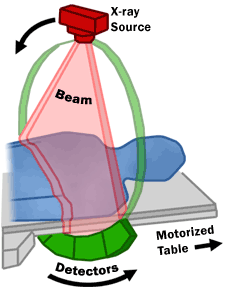The word electricity refers generally to the movement of electrons (or other charge carriers) through a conductor in the presence of potential and an electric field.
The speed of this flow has multiple meanings. In everyday electrical
and electronic devices, the signals or energy travel as electromagnetic
waves typically on the order of 50%–99% of the speed of light, while the electrons themselves move (drift) much more slowly.
Electromagnetic waves
The speed at which energy or signals travel down a cable is actually
the speed of the electromagnetic wave traveling along (guided by) the
cable. i.e. a cable is a form of a waveguide.
The propagation of the wave is affected by the interaction with the
material(s) in and surrounding the cable, caused by the presence of
electric charge carriers (interacting with the electric field component)
and magnetic dipoles (interacting with the magnetic field component).
These interactions are typically described using mean field theory by the permeability and the permittivity
of the materials involved.
The energy/signal usually flows overwhelmingly outside the electric
conductor of a cable; the purpose of the conductor is thus not to
conduct energy, but to guide the energy-carrying wave.
Speed of electromagnetic waves in good dielectrics
The speed of electromagnetic waves in a low-loss dielectric is given by
- .
where
- = speed of light in vacuum.
- = the permeability of free space = 4π x 10−7 H/m.
- = relative magnetic permeability of the material. Usually in good dielectrics, eg. vacuum, air, Teflon, .
- = .
- = the permitivity of free space = 8.854 x 10−12 F/m.
- = relative permitivity of the material. Usually in good conductors eg. copper, silver, gold, .
- = .
Speed of electromagnetic waves in good conductors
The speed of electromagnetic waves in a good conductor is given by
- .
where
- = frequency.
- = angular frequency = 2πf.
- = conductivity of annealed copper = 5.96 x 107 S/m.
- = conductivity of the material relative to the conductivity of copper. For hard drawn copper may be as low as 0.97.
- = .
In copper at 60 Hz, 3.2 m/s. Some sprinters can run more than three times as fast. As a consequence of Snell's Law
and the extremely low speed, electromagnetic waves always enter good
conductors in a direction that is normal to the surface, regardless of
the angle of incidence. This velocity is the speed with which
electromagnetic waves penetrate into the conductor and is not the drift velocity of the conduction electrons.
Electromagnetic waves in circuits
In
the theoretical investigation of electric circuits, the velocity of
propagation of the electromagnetic field through space is usually not
considered; the field is assumed, as a precondition, to be present
throughout space. The magnetic component of the field is considered to
be in phase with the current, and the electric component is considered
to be in phase with the voltage. The electric field starts at the
conductor, and propagates through space at the velocity
of light (which depends on the material it is traveling through). Note
that the electromagnetic fields do not move through space. It is the
electromagnetic energy that moves, the corresponding fields simply grow
and decline in a region of space in response to the flow of energy. At
any point in space, the electric field corresponds not to the condition
of the electric energy flow at that moment, but to that of the flow at a
moment earlier. The latency is determined by the time required for the
field to propagate from the conductor to the point under consideration.
In other words, the greater the distance from the conductor, the more
the electric field lags.
Since the velocity of propagation is very high – about 300,000
kilometers per second – the wave of an alternating or oscillating
current, even of high frequency, is of considerable length. At 60
cycles per second, the wavelength is 5,000 kilometers, and even at
100,000 hertz, the wavelength is 3 kilometers. This is a very large
distance compared to those typically used in field measurement and
application.
The important part of the electric field of a conductor extends
to the return conductor, which usually is only a few feet distant. At
greater distance, the aggregate field can be approximated by the
differential field between conductor and return conductor, which tend to
cancel. Hence, the intensity of the electric field is usually
inappreciable at a distance which is still small compared to the
wavelength. Within the range in which an appreciable field exists, this
field is practically in phase with the flow of energy in the conductor.
That is, the velocity of propagation has no appreciable effect unless
the return conductor is very distant, or entirely absent, or the
frequency is so high that the distance to the return conductor is an
appreciable portion of the wavelength.
Electric drift
The drift velocity
deals with the average velocity of a particle, such as an electron, due
to an electric field. In general, an electron will propagate randomly
in a conductor at the Fermi velocity.
Free electrons in a conductor follow a random path. Without the
presence of an electric field, the electrons have no net velocity. When
a DC voltage
is applied, the electron drift velocity will increase in speed
proportionally to the strength of the electric field. The drift velocity
is on the order of millimeters per hour. AC voltages
cause no net movement; the electrons oscillate back and forth in
response to the alternating electric field.























